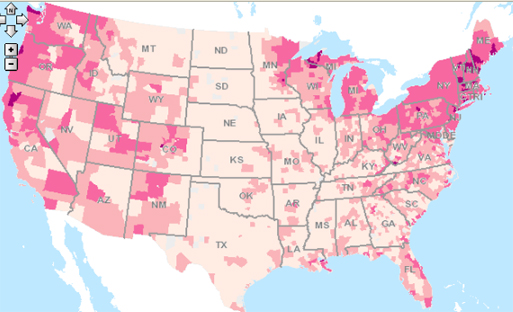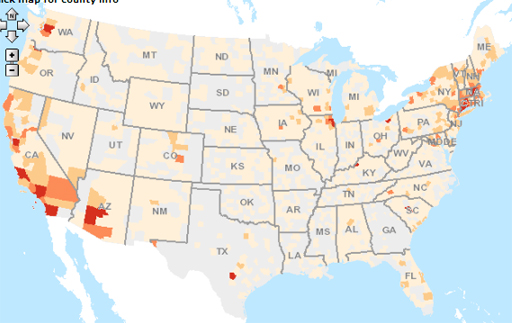I found an interesting online tool called the Food Environmental Atlas that generates maps based on your criteria.
In the Local Food category, this is the map for the Percent of Farms with Direct Sales (the darker colors represent a higher percentage).
The next map is the Number of Farmers Markets. Again the darker the colors represent more markets.
I find it interesting that there are fewer direct sales and fewer farmers markets in regions that I thought were more agricultural. Perhaps everyone there has their own farm?
Anyway, it’s a very neat tool and there are lots of other categories. It also lets you drill down to the state level. I would like to be able to overlay a few categories…


Huh. Interesting. I’d guess that the farmland in the middle of the continent is controlled (directly, or less-directly) by major agribusinesses and its primarily corn and soy? Not exactly farmer’s market friendly? I’d say this applies to the parts of Florida I’m familiar with (though the crop is milk, not corn and soy). Not that that there are no markets, or no small farms, but a statistical analysis would look like this . . .
And I think there was/is a (long, slow) disinvestment in large-scale NE agriculture that actually allows some space for smaller farms (and their markets) to (just barely) survive . . .
I also feel like there are people who know a lot more about this history than I do! I’m surprised you didn’t get more comments . . .
Hi Zoe: I think you’re right about the middle being BigAg farms who wouldn’t be selling directly to consumers. I also think you’re right about them being predominantly corn and soy, which would make for some pretty boring farmers markets. It turns out that government subsidies are based on a crop so that any farm receiving them can only grow the subsidized crop. So, they couldn’t save a few acres for say, tomatoes and basil for the farmers market.
I also wouldn’t be surprised if many of those crops weren’t for human consumption, but instead for bio-diesel and feed.
i always use Biodiesel on my car to help the environment. Biodiesel is cleaner and is reneweable.,,: